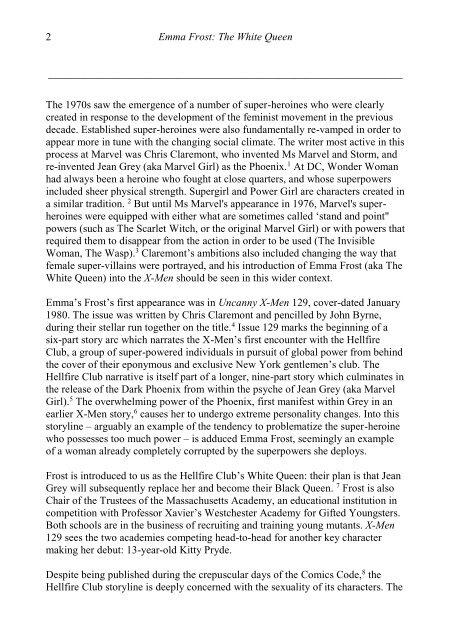You also want an ePaper? Increase the reach of your titles
YUMPU automatically turns print PDFs into web optimized ePapers that Google loves.
2<br />
Emma Frost: The White Queen<br />
__________________________________________________________________<br />
The 1970s saw the emergence of a number of super-heroines who were clearly<br />
created in response to the development of the feminist movement in the previous<br />
decade. Established super-heroines were also fundamentally re-vamped in order to<br />
appear more in tune with the changing social climate. The writer most active in this<br />
process at Marvel was Chris Claremont, who invented Ms Marvel and Storm, and<br />
re-invented Jean Grey (aka Marvel Girl) as the Phoenix. 1 At DC, Wonder Woman<br />
had always been a heroine who fought at close quarters, and whose superpowers<br />
included sheer physical strength. Supergirl and Power Girl are characters created in<br />
a similar tradition. 2 But until Ms Marvel's appearance in 1976, Marvel's superheroines<br />
were equipped with either what are sometimes called ‘stand and point"<br />
powers (such as The Scarlet Witch, or the original Marvel Girl) or with powers that<br />
required them to disappear from the action in order to be used (The Invisible<br />
Woman, The Wasp). 3 Claremont’s ambitions also included changing the way that<br />
female super-villains were portrayed, and his introduction of Emma Frost (aka The<br />
White Queen) into the X-Men should be seen in this wider context.<br />
Emma’s Frost’s first appearance was in Uncanny X-Men 129, cover-dated January<br />
1980. The issue was written by Chris Claremont and pencilled by John Byrne,<br />
during their stellar run together on the title. 4 Issue 129 marks the beginning of a<br />
six-part story arc which narrates the X-Men’s first encounter with the Hellfire<br />
Club, a group of super-powered individuals in pursuit of global power from behind<br />
the cover of their eponymous and exclusive New York gentlemen’s club. The<br />
Hellfire Club narrative is itself part of a longer, nine-part story which culminates in<br />
the release of the Dark Phoenix from within the psyche of Jean Grey (aka Marvel<br />
Girl). 5 The overwhelming power of the Phoenix, first manifest within Grey in an<br />
earlier X-Men story, 6 causes her to undergo extreme personality changes. Into this<br />
storyline – arguably an example of the tendency to problematize the super-heroine<br />
who possesses too much power – is adduced Emma Frost, seemingly an example<br />
of a woman already completely corrupted by the superpowers she deploys.<br />
Frost is introduced to us as the Hellfire Club’s White Queen: their plan is that Jean<br />
Grey will subsequently replace her and become their Black Queen. 7 Frost is also<br />
Chair of the Trustees of the Massachusetts Academy, an educational institution in<br />
competition with Professor Xavier’s Westchester Academy for Gifted Youngsters.<br />
Both schools are in the business of recruiting and training young mutants. X-Men<br />
129 sees the two academies competing head-to-head for another key character<br />
making her debut: 13-year-old Kitty Pryde.<br />
Despite being published during the crepuscular days of the Comics Code, 8 the<br />
Hellfire Club storyline is deeply concerned with the sexuality of its characters. The


